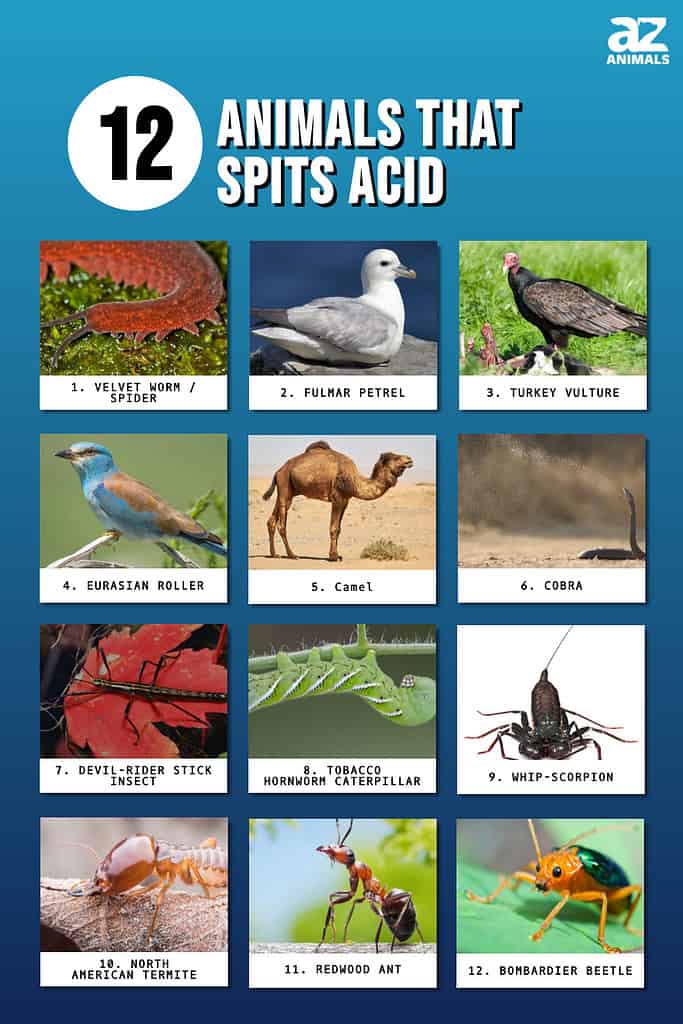
You’ve seen it in horror and science fiction movies – an alien creature that can spit acid, dissolving obstacles or its opponents. Did you know that there are real animals that can shoot acid, venom, or other liquid projectiles as a form of defense? Yes, you read that right – real animals that spit acid.
What is acid? Acidic chemicals are corrosive – they dissolve substances and cause burns – and are sour-tasting. Acidity is measured in pH, which is a logarithmic scale. That means that each number is 10xs higher than the one before. A pH of 5 is considered neutral. The lower the number, the stronger the acid. There are mild acids, such as those found in tomato juice, which have a pH of 4.4. Vinegar is a stronger acid and is usually around 2pH. Really strong acids are very dangerous and are in the pH range of 0-1.
Why do animals use acid? They use it as a defense mechanism. The smell, taste, or painful burning sensation caused by the acid may make a predator think twice about its next meal.
Check out our list of animals that spit acid.
#12 Bombardier Beetle: This Beetle Squirts Boiling Chemicals from Its Butt
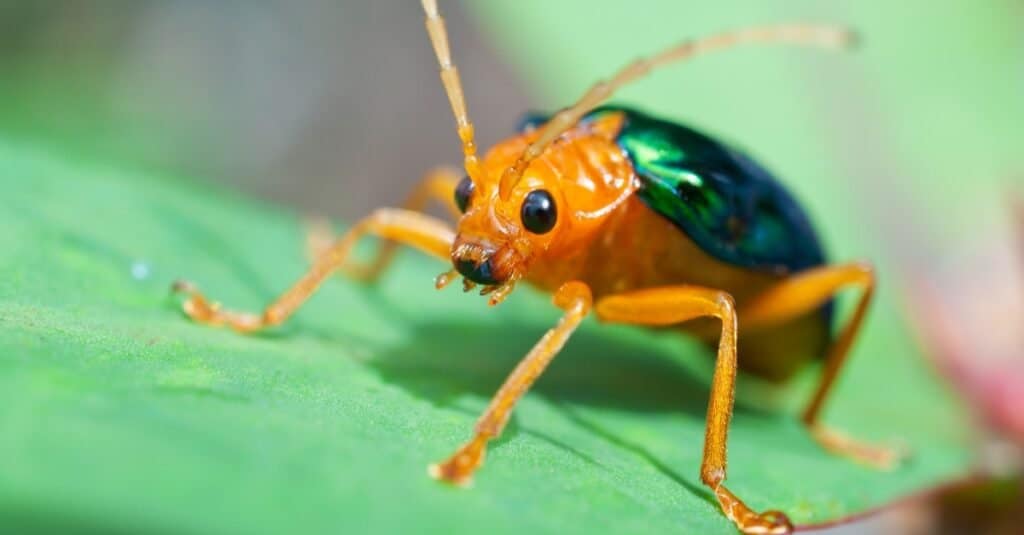
©johannviloria/Shutterstock.com
Bombardier beetles are ground beetles that have the ability to shoot heated chemicals from their abdomen – boiling water, in fact. How does the beetle do this without harming itself?
There are two glands at the tip of the abdomen. Each gland has hydrogen peroxide and an acid reservoir. When threatened, it squeezes the contents of the reservoir into a “reaction chamber” filled with water and enzymes. A chemical reaction results, heating the water to 212 degrees Fahrenheit. The reaction also produces pressure, which shoots the boiling water, steam, and foul chemicals.
Though the reaction chamber is only 1/16 of an inch, the beetle is able to aim and control the speed and potency of the spray. Its eruption is so intense that it causes an explosive sound.
If eaten, the bombardier beetle will still use its defense. This may cause frogs or other predators to vomit them out! There are actually about 500 species of acid-shooting beetles, found on every continent except Antarctica.
#11 Ants That Spray Formic Acid
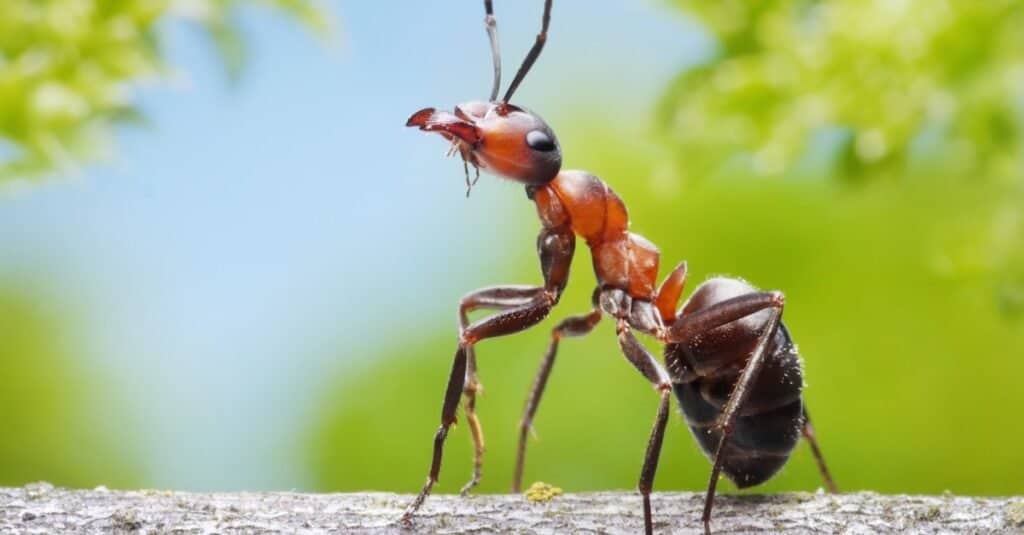
©iStock.com/Antrey
Most ants have stingers, and they use these to inject formic acid, which causes pain and a rash. This is what gives fire ants their name. A few species, though, spray acid rather than stinging. The formic acid is stored in a sack in the ant’s abdomen, and it can make up 20 percent of the ant’s total weight!
The redwood ant is the most well-known of the acid-spitting ants. It lives in a colony of up to half a million individuals. When threatened, thousands of ants shoot acid several inches into the air.
Interestingly, some birds have learned that formic acid is helpful in removing pests, such as mites and ticks. They will intentionally harass the ants by stepping on them in order to get them to release the formic acid “bath.”
The Malaysian ant uses its poison in a different way. It has poison sacks within its head, back, and abdomen. When it senses danger, it contracts muscles to increase the pressure on these sacks. The sacks explode, killing the ant but showering the predator with poison.
The oogpister beetle is also able to spray formic acid. It probably derives the acid from the ants it eats.
#10 Blind Termites With Fontanellar Guns
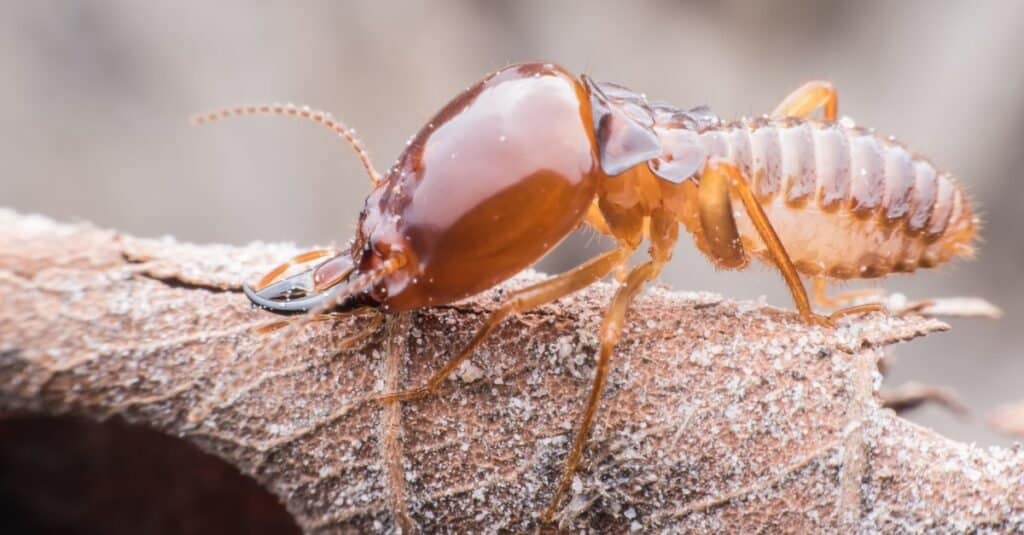
©PK289/Shutterstock.com
Some North American termites have a “gun” on their heads. This hornlike projection, called a fontanellar gun, emits a sticky fluid that the insects use to dissuade predators. Though blind, the termite can accurately spray at a range of several centimeters – a distance larger than the size of the insect. This adaptation is famously featured in the animated film Antz.
#9 The Whip-Scorpion’s Weapon

A Whip Scorpion walking through thick moss. While they are not venomous, they can spray an acidic mix that has a vinegar-like smell.
©Matee Nuserm/Shutterstock.com
Whip scorpions are arachnids. They have claws like scorpions, but they lack a stinging tail or venomous fangs. Instead, spray an acid that smells like vinegar – but that is 20 times stronger than vinegar – from two “turrets” on the abdomen. They use the whip-like tail to direct the spray. This acid probably wouldn’t burn your skin, but it could damage your eyes. This distraction gives the whip scorpion enough time to escape from a potential predator.
#8 Tobacco Hornworm: Toxic Caterpillar Breath
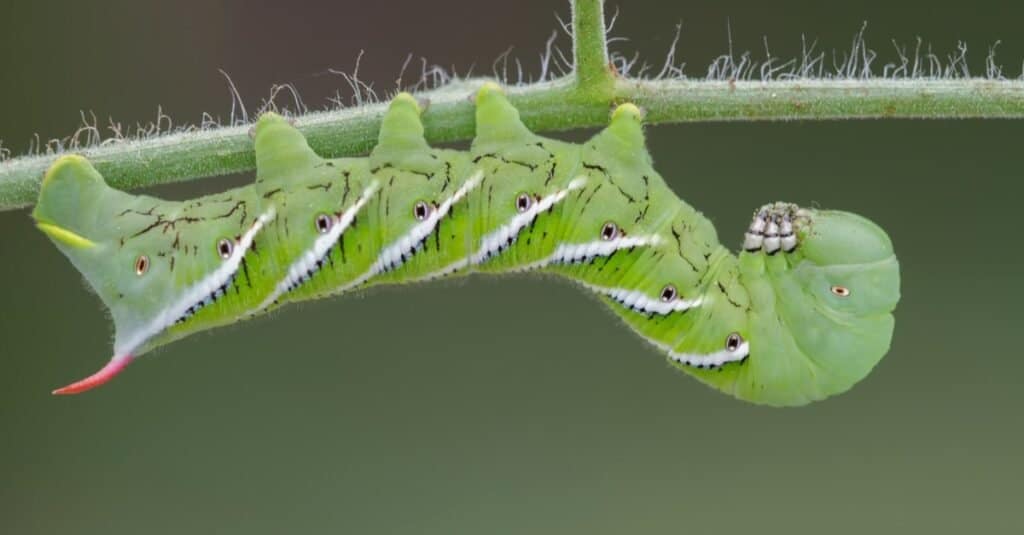
©vbalson/Shutterstock.com
The tobacco hornworm caterpillar consumes the toxic tobacco plant. It then secretes the toxins, including nicotine, through its skin in order to scare away predators. Researchers call this “defensive halitosis,” or bad breath.
Hornworm caterpillars use this feature to scare off wolf spiders, ladybugs, and green lacewings. But, if you are a gardener, you may find yourself rooting for the predators in this battle. These caterpillars have huge appetites and are known for destroying crops.
#7 The Glands of the Devil-Rider Stick Insect
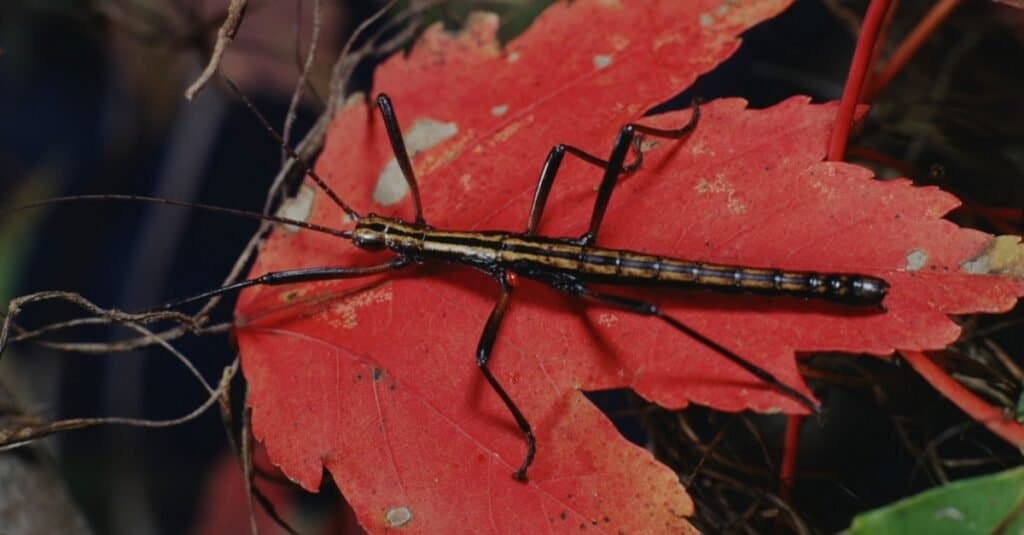
©Liz Weber/Shutterstock.com
This stick insect can propel chemical compounds called terpenes from glands on its metathorax, on its back near the third pair of legs. The chemical produces an intense burning sensation when it encounters a predator’s eyes or mouth. The spray is strong enough to knock other insects from the stick insect’s back!
This stick insect is born with the ability to defend itself in this way. Even stick insect nymphs have been observed shooting terpenes at attacking ants.
#6 The Venom of Spitting Cobras
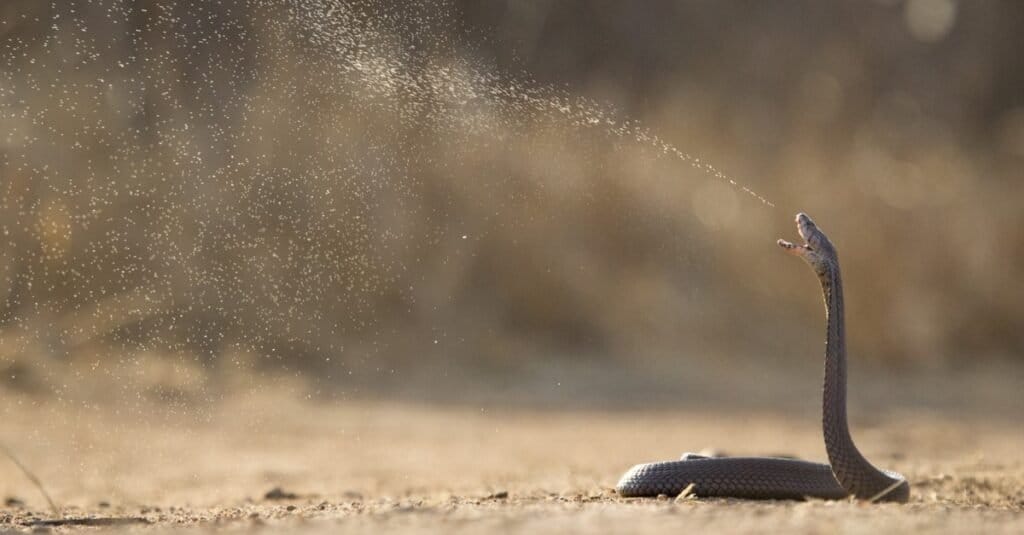
©Stu Porter/Shutterstock.com
There are twelve species of spitting cobras. Unlike other snakes that use needle-like fangs to inject their venom, spitting cobras use their fangs to spray it. The snakes do this by squeezing the muscles around the venom glands.
Spitting cobras are frighteningly accurate. At a range of 6 feet, they are 90 percent accurate at directing the venom spray to the victim’s eyes. At a distance of 2 feet, they are 100 percent accurate. They can also bite and inject venom if you get too close.
What happens if you get hit by spitting cobra venom? Its venom is a neurotoxin, meaning it acts on the nervous system. While not usually deadly, the venom will cause pain, tissue damage, especially of the cornea and mucus membranes, and occasionally even blindness.
Interestingly, most snake venoms are tasteless, but cobra venom has a slightly bitter taste if you’re unlucky enough to get some in your mouth. This indicates its acidic nature.
#5 Do Camels Spit Acid?
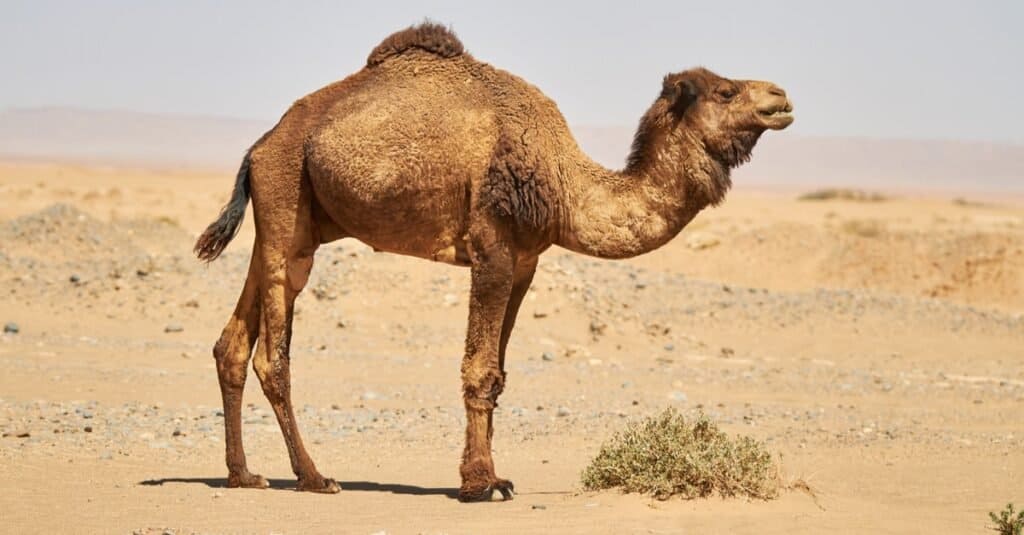
©Photoestetica/Shutterstock.com
Camels spitting on someone they don’t like is common in comedy. It is also a real defense they utilize when another animal gets too close. What the camel spits is mostly vomit, which includes digestive acids from the stomach. Other camelids, such as Llamas, also spit when threatened or annoyed.
Chemical Warfare Of Birds
A number of birds employ projectile vomiting to keep predators at bay. Consider the following outstanding examples.
#4 Acidic Vomit of the Eurasian Roller
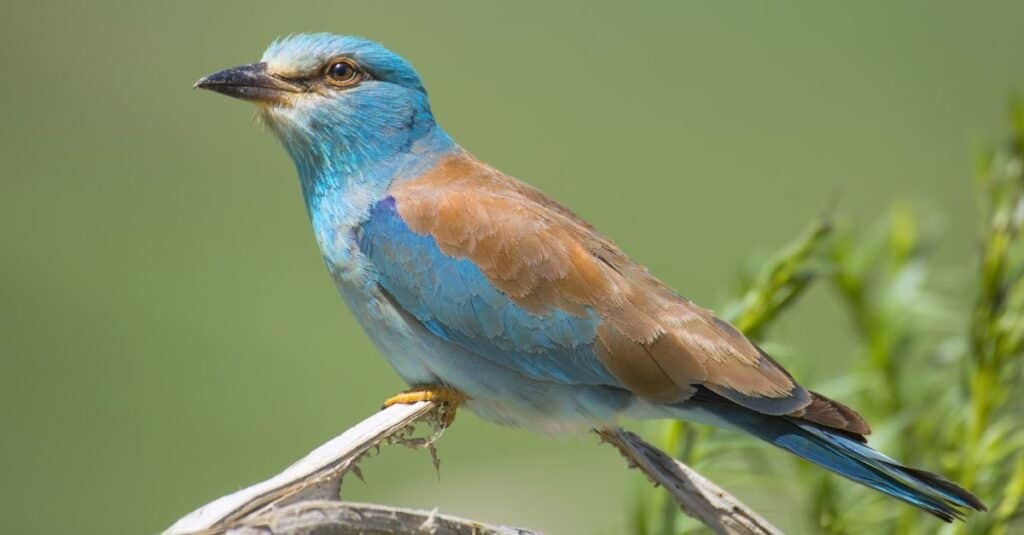
©Tati Menshikova/Shutterstock.com
A small bird called the Eurasian roller loves to eat grasshoppers. When threatened, the grasshopper releases chemicals derived from the plants they eat in hopes of leaving a bad taste in the bird’s mouth. That may work for some birds, but not the roller. In fact, the roller is able to store some of these chemicals in its body. When it is disturbed, it vomits up the orange chemicals in a mass, the smell of which may keep predators away.
#3 Avoid the “Splash Zone” of the Turkey Vulture
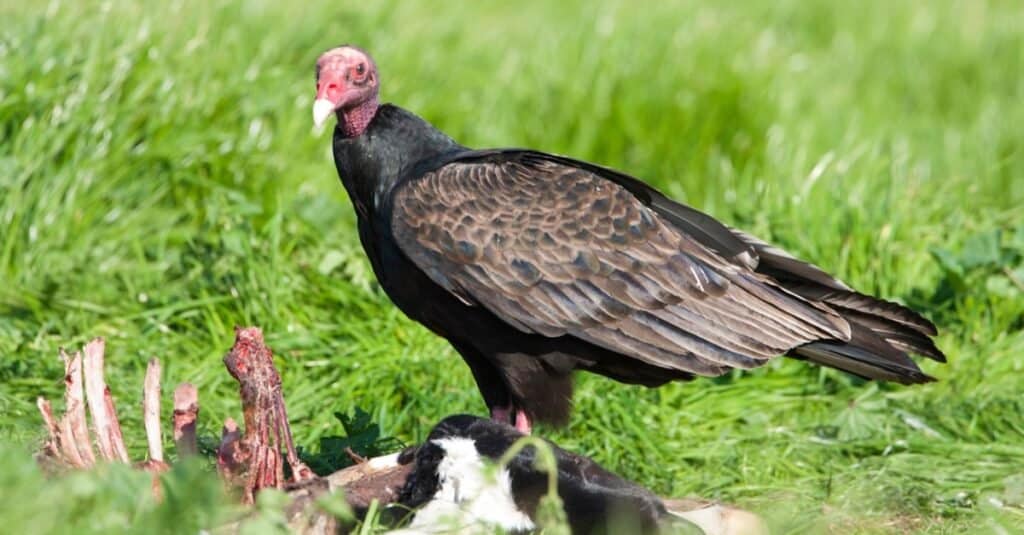
©Agami Photo Agency/Shutterstock.com
The American turkey vulture utilizes a similar strategy. If a predator approaches a nest, adult birds vomit stomach contents in a projectile manner. Not only is this potion acidic, but it may contain bacteria and foul-smelling partially-digested carrion.
#2 Fulmar Petrel: The Fulmar’s Oily Acid

©AndreAnita/Shutterstock.com
The Fulmar petrel, a type of seabird, extracts an orange oily substance from its food. When threatened, it can spit the oil up to six feet. This substance mats feathers and eats away at their waterproofing oils. Even eagles have been known to die of cold or drowning after getting spit upon by a Fulmar.
#1 Velvet Worm/Spider: Worms And Spiders That Spit Glue
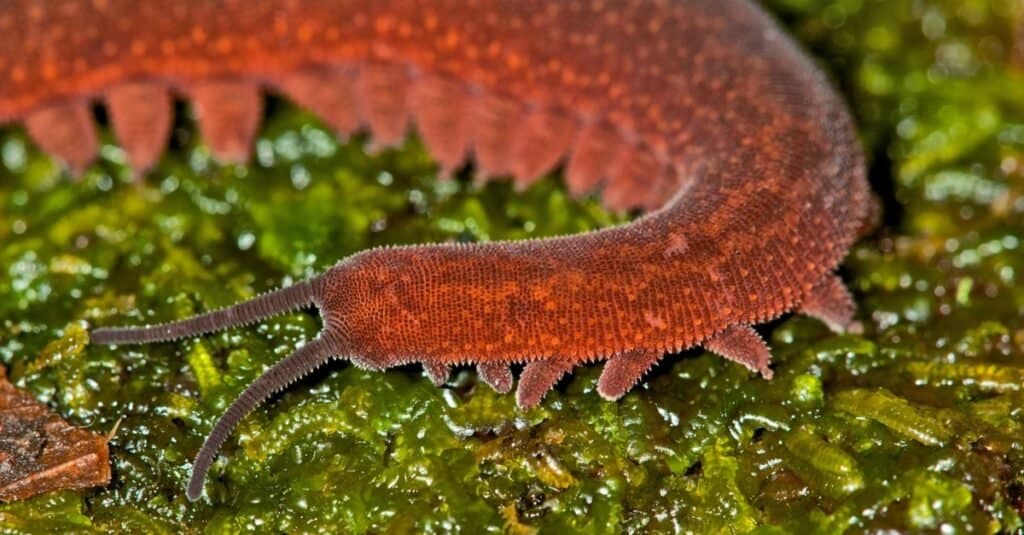
©Pedro Bernardo/Shutterstock.com
Velvet worms are many-legged invertebrates that resemble centipedes. It can project a “slimy adhesive fluid” from glands located on the sides of its head. It uses this sticky slime to trap prey.
Spitting spiders take this tactic a bit further. They spit a fluid that contains liquid spider silk as well as venom. When the liquid reaches the prey, it congeals into a sticky mass that immobilizes small insects. The spitting spider then finishes the kill with a venomous bite. Spitting spiders live on every continent except Antarctica.
Why Didn’t The Skunk Make Our List?
Perhaps you’re wondering why the skunk, one of the most famous liquid-shooting animals, didn’t make our list. The reason is that the skunk’s smelly liquid is not acidic; it is alkaline. That is why some home remedies recommend using acidic tomato juice to help hasten the removal of the skunk smell if you get sprayed.
Summary Of The 12 Animals That Spit Acid
What Animal has the Most Toxic Saliva?

A duck-billed
platypus
is a semiaquatic egg-laying mammal endemic to eastern Australia, including Tasmania.
©Martin Pelanek/Shutterstock.com
There are quite a variety of animals, more specifically mammals, that have toxic saliva. Some of these are the Eurasian and Mediterranean water shrews and the short-tailed shrew, whose saliva contains a venom that when administered will have a paralytic effect on its prey. However, the most venomous animal on the planet is the duck-billed platypus.
The duck-billed platypus (Ornithorhynchus anatinus), also called simply, the platypus, is one of the few species of venomous mammals. However, this venom is only produced in the males of the species and is found on their hind legs in a pair of spurs that secrete the toxic substance seasonally. While it is not technically in their saliva, it is still the most potent. This substance is used not only as a means of protection but also against other males when competing for mates. This toxin is powerful enough to paralyze and kill smaller animals, including dogs, but it is not lethal to humans, although it will cause intense pain that may last for weeks.
The photo featured at the top of this post is © Eugene Troskie/Shutterstock.com
Thank you for reading! Have some feedback for us? Contact the AZ Animals editorial team.







